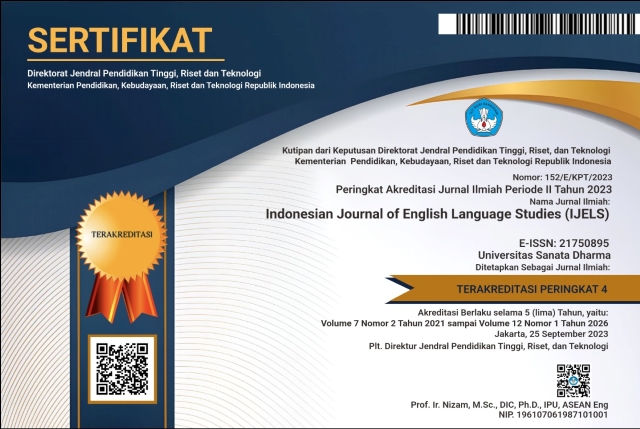Introducing SDL Trados to Beginning Translators
(1)
(2)
(3)
(4)
(*) Corresponding Author
Abstract
Over years, translators have been incorporating new advances in technology into their work. A number of attempts in developing ideal translator’s workstations using technology have been made, one of such stations is a Computer-Aided Translation (CAT) tool. CAT tools facilitate translators to increase their productivity and efficiency by providing them with some utilities, such as a Translation Memory and an Alignment Tool to support their translation works. This article highlights the usefulness of SDL Trados 2014, as one of the most widely used paid CAT tools, in translating the texts more effectively and in a timely manner. Further, it describes the basic steps in using SDL Trados and exemplifies SDL Trados 2014 translation results. A sample text was translated from Indonesian to English using both Across (a free CAT tool) and SDL Trados (a paid CAT tool). Eventually, the results of translating using both CAT tools appear to prove that SDL Trados helps the translators to translate more consistently, accurately, effectively and in a timely-manner.
Keywords
Full Text:
PDFReferences
Advantages and disadvantages of SDL Trados and Wordfast. (2012). Retrieved from http://www.translationartwork.com/a dvantages-and-disadvantages-of-sdl- trados-and-wordfast/.
Alotaibi, H. M. (2014). Teaching CAT Tools to Translation Students: An examination of their experiences and attitudes. Arab World English Journal, ISSN (3): p.65-74.
Bowker, L. (2015). Productivity vs quality: a pilot study on the impact of translation memory systems. Research.loc.
Cocci, L. (2009). CAT tools for beginners. Translation Journal, 13(4).
Edo Marzá, N. (2011). Terminology management systems for the development of (specialized) dictionaries: a focus on WordSmith Tools and Termstar XV. Language Value 3, 162-173.
Example: Project package translation workflow in SDL Trados. (2010). Retrieved from http://producthelp.sdl.com/SDL%20Trados%20Studio/client_en/SDL_Tr ados_Studio_Help.htm#StarterEditio n/Ex_PackTransStarter.htm.
Garcia, I. (2009). Beyond translation memory: Computers and professional translator. The Journal of Specialized Translation. Issue 12, 199-214.
Introduction to Wordfast. (2013). Retrieved from localization guide. readthedocs.org/en/latest/guide/introduction_to_wordfast.html.
Lee, M. (2010). Working together for free software. Retrieved from http://www.fsf.org/working- together/working-together-for-free- software.
McKay, C. (2006). Free and Open Source Software for translators. Panacea, VII, 95-98. Retrieved from http://www.medtrad.org/panacea/IndiceGeneral/n23_tribuna_McKay.pd.
Overview: Screen layout and functionality. (2010). Retrieved from http://producthelp.sdl.com/SDL%20
Trados%20Studio/client_en/SDL_Tr ados_Studio_Help.htm#Edit_View/T ranslating/EV_About_Verifying_Tra nslations.htm.
Parra, M.F. (2010). The Workflow of Computer-Assisted Translation Tools in Specialized Translation. The XVII European LSP Symposium.
Polo, L. (2013). Managing the translation workflow with a computer assisted translation tool: SDL Trados 2011. Language Value Journal vol. 5 (1),161-174.
Samuelsson-Brown, G. (2010). A practical guide for translators. United Kingdom: Short Run Press Ltd.
Screen layout and functionality. (2010). Retrieved from http://producthelp.sdl.com/SDL%20 Trados%20Studio/client_en/SDL_Tr ados_Studio_Help.htm#Edit_View/T ranslating/EV_About_Verifying_Tra nslations.htm.
What is a Computer-Assisted Translation Tool (CAT)? (2014). Retrieved from http://www.pangeanic.com/knowled ge_center/computer-assisted- translation-tool-cat/#.
DOI: https://doi.org/10.24071/ijels.v2i1.353
Refbacks
- There are currently no refbacks.

This work is licensed under a Creative Commons Attribution-ShareAlike 4.0 International License.
IJELS Journal Sinta 4 Certificate (S4 = Level 4)
We would like to inform you that Indonesian Journal of English Language Studies (IJELS) has been nationally accredited Sinta 4 by the Ministry of Education, Culture, Research and Technology of the Republic of Indonesia based on the decree No. Surat Keputusan 152/E/KPT/2023. Validity for 5 years: Vol 7 No 2, 2021 till Vol 12 No 1, 2026

This work is licensed under CC BY-SA.
Creative Commons Attribution-ShareAlike 4.0 International License
IJELS e-ISSN 2715-0895; IJELS p-ISSN 2442-790X
Indonesian Journal of English Language Studies (IJELS) is published twice a year, namely in March and September, by the English Language Studies (ELS) of the Graduate Program of Sanata Dharma University, Yogyakarta, Indonesia.


 IJELS p-ISSN:
IJELS p-ISSN: 









